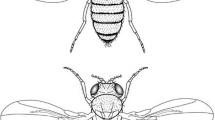Overview
- Editors:
-
-
Jean S. Deutsch
-
Developmental Biology, Pierre and Marie Curie University, Paris, France
- Devoted to the evolution of Hox genes and Hox complexes, in relation to animal evolution
- Discusses function of the Hox genes at the organism level
- Biological function of the Hox genes in the Bilateria
Access this book
Other ways to access
About this book
In his 1894 book, Materials for the Study of Variation, William Bateson coined the term Homoeosis with the following prose: The case of the modification of the antenna of an insect into a foot, of the eye of a Crustacean into an antenna, of a petal into a stamen, and the like, are examples of the same kind. It is desirable and indeed necessary that such Variations, which consist in the assumption by one member of a Meristic series, of the form or characters proper to other members of the series, should be recognized as constituting a distinct group of phenomena. ...I therefore propose...the term HOMOEOSIS...; for the essential phenomenon is not that there has merely been a change, but that something has been changed into the likeness of something else. The book was intended as a listing of the kinds of naturally occurring variation that could act as a substrate for the evolutionary process and Bateson took his examples from collections, both private and in museums, of materials displaying morphological oddities. Interestingly the person who also coined the term “Genetics” proffered little in the way of speculation on the possible genetic underpinnings of these oddities. It wasn’t until the early part of the next century that these changes in meristic series were shown to be heritable.
Similar content being viewed by others
Table of contents (12 chapters)
-
Front Matter
Pages i-xxiii
-
Mechanisms of Activity
-
-
- Samir Merabet, Nagraj Sambrani, Jacques Pradel, Yacine Graba
Pages 3-16
-
- Robert K. Maeda, François Karch
Pages 17-40
-
- Samantha Beck, Floria Faradji, Hugh Brock, Frédérique Peronnet
Pages 41-62
-
-
Evolution of Hox Genes and Complexes
-
-
- Bernd Schierwater, Kai Kamm
Pages 81-90
-
-
- Aziz Aboobaker, Mark Blaxter
Pages 101-110
-
-
Biological Function
-
Front Matter
Pages 123-123
-
-
- Urs Schmidt-Ott, Ab. Matteen Rafiqi, Steffen Lemke
Pages 133-144
-
- Heinrich Reichert, Bruno Bello
Pages 145-153
-
-
Back Matter
Pages 167-169
Editors and Affiliations
-
Developmental Biology, Pierre and Marie Curie University, Paris, France
Jean S. Deutsch
About the editor
JEAN S. DEUT SCH, is Emeritus Professor of Genetics and Animal Biology, Université Pierre et Marie Curie, Paris 6, Department (UMR 7622) “Biologie du Développement”. Under the supervision of Prof. P.P. Slonimski, he participated to the birth of mitochondrial genetics of the yeast Saccharomyces cerevisiae. During the ‘80s, he moved to the Institut Jacques Monod in Paris to study developmental genetics of Drosophila melanogaster, focusing on the genetics of the hormonal control of metamorphosis. In 1993, he was the first in France, together with André Adoutte, to undertake evo-devo studies, choosing the cirripedes, which
have been Darwin’s favourite animals, as a model, because of their so peculiar
body plan. In a second step, his team studied the developmental genetics of other arthropods, including scorpions and pycnogonids. He is author of a number of scientific publications in international journals, and of three textbooks in French on Drosophila and genetics.




